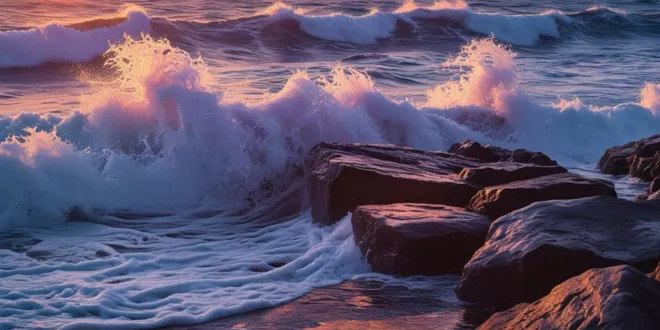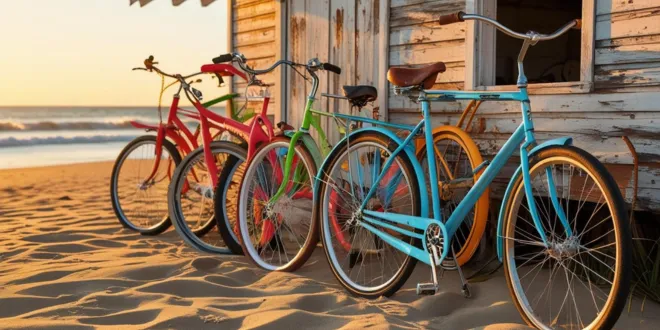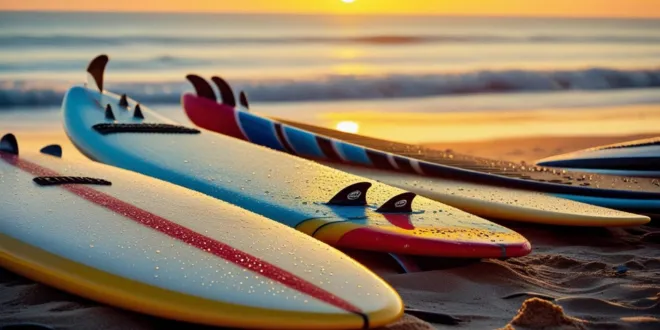When it comes to world-class surfing, few places match the raw power and prestige of Hossegor Autumn Swell. Nestled on France’s southwestern coast, Hossegor transforms into a surfing mecca each fall as Atlantic storms generate powerful swells that roll into its sandy beaches and reef breaks.
If you’re wondering what to expect from the autumn swell in Hossegor, prepare for consistent, high-energy waves that attract surfers from every corner of the globe.
The Hossegor surf season truly peaks between September and November, making this period the best time to surf the autumn swell in Hossegor.
During these months, wave heights regularly reach 6 to 15 feet, offering perfect conditions for experienced riders seeking thrilling barrels and fast, powerful breaks.
But what makes this season so special? Why Hossegor’s autumn swell attracts pro surfers worldwide is simple: reliability, quality, and intensity.
The unique sandbar formations create long, rideable waves ideal for high-performance surfing, while the town’s vibrant surf culture and infrastructure support both competitions and casual sessions.
Whether you’re watching the Quiksilver Pro or paddling out yourself, the energy is electric.Of course, with great waves come risks.
That’s why top tips for riding the autumn swell in Hossegor safely include checking local surf reports, respecting rip currents, and knowing your limits.
Compared to other destinations, Hossegor vs. other European spots stands out for its consistency and crowd of passionate surfers. In this guide, we’ll break down everything you need to make the most of this legendary season.

What to Expect from the Autumn Swell in Hossegor
The autumn swell in Hossegor brings some of the most powerful and consistent surf conditions in Europe. As Atlantic storms intensify from September to November, they generate long-period swells that transform Hossegor’s beach breaks into world-class waves.
Expect fast, barreling rides shaped by shifting sandbanks, particularly at legendary spots like La Gravière and Les Culs Nuls. Water temperatures drop to 15–18°C, requiring a 4/3mm wetsuit, while onshore winds can be unpredictable—offshore breezes often deliver the cleanest conditions.
The surf season peaks during this time, drawing crowds of experienced surfers and competitors. You’ll encounter a vibrant atmosphere, with surf festivals and pro events adding to the energy.
While the waves are ideal for intermediates and advanced riders, beginners may find conditions overwhelming. Rip currents and shallow breaks demand respect and local knowledge.
Overall, the autumn swell offers thrilling, high-performance surfing in one of the world’s most iconic surf towns—perfect for those chasing powerful waves and authentic surf culture.
Best Time to Surf the Autumn Swell in Hossegor
The best time to surf the autumn swell in Hossegor is from late September through October and into early November. This period offers the most reliable combination of powerful swells, favorable wind conditions, and well-formed sandbanks.
October, in particular, stands out as the peak month—delivering consistent offshore winds and large, rideable waves without the extreme cold of late November.
Swells generated by North Atlantic storms reach their strength during this window, creating ideal conditions for barreling beach breaks.
While November can still offer epic surf, it often comes with stronger winds, colder water, and larger, more dangerous waves. Summer months are crowded with tourists and smaller waves, making autumn the preferred season for serious surfers.
By timing your trip for October, you maximize your chances of experiencing clean, powerful surf with fewer weather disruptions. Whether you’re aiming to ride like the pros or witness the Quiksilver Pro event, this timeframe delivers the ultimate Hossegor experience.

Hossegor Autumn Swell
The Hossegor autumn swell is a defining event in the European surf calendar. Each fall, powerful low-pressure systems in the North Atlantic generate long-period swells that travel toward France’s southwestern coast, arriving with immense energy.
These swells interact with Hossegor’s dynamic sandbanks to create fast, hollow, and often barreling waves—perfect for high-performance surfing. The swell season typically runs from September to November, peaking in October when conditions are most consistent.
Hossegor’s unique geography amplifies wave quality, making it a magnet for surfers seeking powerful beach breaks. The town buzzes with activity during this time, hosting major competitions like the Quiksilver Pro and attracting media, photographers, and fans.
However, the swell also brings challenges: strong rips, shallow water, and crowded lineups. Safety awareness and experience are crucial. Beyond the surf, the autumn swell symbolizes the heart of European surf culture—blending adrenaline, tradition, and nature’s raw power. For many, riding the Hossegor autumn swell is a bucket-list experience.
Why Hossegor’s Autumn Swell Attracts Pro Surfers Worldwide
- World-class wave quality
- Consistent swells
- Host to major competitions
- Ideal wind conditions
- Challenging and dynamic breaks
- Global surf media attention
- Vibrant surf culture
- Perfect timing
- Scenic and professional environment
- Reputation and legacy
World-Class Wave Quality
These spots offer flawless, powerful waves with perfect shape (e.g., Pipeline, Jeffreys Bay). Ideal for high-performance surfing, barrels, and long rides. Only experts should attempt them due to their intensity and danger.
Consistent Swells
Reliable year-round waves thanks to favorable oceanography (e.g., Indonesia, Costa Rica). Ensures surfers rarely face flat spells, making it a top destination for surf trips.
Host to Major Competitions
Iconic venues like Teahupo’o (Tahiti) and Banzai Pipeline host the WSL Championship Tour. These events draw elite surfers and global audiences.
Ideal Wind Conditions
Offshore winds groom waves into clean, rideable faces (e.g., Gold Coast’s Snapper Rocks). Light morning winds often provide the best sessions.
Challenging and Dynamic Breaks
Powerful, shifting waves (e.g., Mavericks, Nazaré) test skill and bravery. Shallow reefs, heavy barrels, and strong currents add to the difficulty.
Global Surf Media Attention
Famous breaks attract filmmakers, photographers, and magazines (e.g., “The Endless Summer” spots). Social media amplifies their legendary status.
Vibrant Surf Culture
Local communities live and breathe surfing (e.g., North Shore, Bali). Surf shops, festivals, and traditions create a unique atmosphere.
Perfect Timing
Tides, swell direction, and wind align for epic sessions (e.g., Cloudbreak at low tide). Knowledge of these factors maximizes wave quality.
Scenic and Professional Environment
Stunning backdrops (e.g., Tavarua Island, Portugal’s Nazaré) with surf schools, resorts, and safety services cater to pros and tourists.
Reputation and Legacy
Historic breaks (e.g., Malibu, Hossegor) shaped surfing history. Their prestige draws surfers seeking to experience legendary waves.

Hossegor Surf Season
The Hossegor surf season reaches its peak during the autumn months, making it one of the most exciting times to visit this legendary French surf town.
While Hossegor offers rideable waves year-round, the real magic happens between September and November, when powerful Atlantic swells begin to hit the coast.
These swells create fast, hollow, and highly rideable waves thanks to the area’s ever-changing sandbanks. The surf season coincides with cooler temperatures and fewer summer tourists, allowing for a more authentic and focused surf experience.
October is widely regarded as the golden month—offering the best mix of swell consistency, offshore winds, and manageable crowds.
The season also features major events like the Quiksilver Pro, drawing top professionals and global media. Hossegor’s surf culture thrives during this time, with surf schools, shops, and bars buzzing with energy.
However, the powerful waves and strong rips mean the season is best suited for intermediate to advanced surfers. Beginners are advised to wait for summer or explore nearby milder spots. Overall, the Hossegor surf season is a must-experience for any serious wave chaser.
Top Tips for Riding the Autumn Swell in Hossegor Safely
- Know your skill level—autumn waves are powerful and best for intermediate to advanced surfers.
- Check daily surf forecasts, tide times, and wind direction before paddling out.
- Respect the rip currents—they are strong and can quickly pull you offshore.
- Avoid overcrowded peaks; go early in the morning for fewer crowds and cleaner waves.
- Wear a 4/3mm wetsuit, booties, and possibly a hood for warmth in cool water.
- Use a durable board leash and ensure your equipment is in good condition.
- Never turn your back on the ocean—watch for incoming sets at all times.
- Stay aware of local etiquette; Hossegor has a competitive lineup with experienced surfers.
- Surf with a buddy, especially in big swell conditions.
- Warm up before entering the water to prevent cramps in colder temperatures.

Hossegor vs. Other European Spots
- Wave Power
- Consistency
- Sandbank Dynamics
- Pro Scene
- Crowds
- Accessibility
- Water Temperature
- Wind Conditions
- Surf Culture
- Beginner-Friendliness
Wave Power
Hossegor delivers some of Europe’s most powerful beach break waves, especially during autumn. Swells refract over sandbanks to create fast, hollow, and often barreling rides. The sheer energy and height of the waves attract experienced surfers seeking thrilling, high-performance sessions in challenging conditions.
Consistency
The Hossegor autumn swell is known for its reliability. Frequent Atlantic storms generate consistent long-period swells from September to November, ensuring rideable waves most days. This predictability makes Hossegor a top choice for surfers planning trips around high-quality, dependable surf.
Sandbank Dynamics
Hossegor’s waves are shaped by ever-changing offshore sandbanks that create world-class breaks like La Gravière. These dynamic formations produce long, barreling rides when aligned perfectly with swell and tide, but can shift rapidly, altering wave quality and requiring local knowledge.
Pro Scene
Hossegor is a global pro surf hub, hosting WSL events like the Quiksilver Pro. Its powerful waves and international reputation draw elite surfers, coaches, and media every autumn, making it a center for competition, training, and high-level surf performance in Europe.
Crowds
Expect large crowds in Hossegor during autumn, especially on weekends and during pro events. The mix of locals, tourists, and pros leads to busy lineups. Early mornings or nearby spots like Capbreton offer slightly quieter alternatives for a more relaxed session.
Accessibility
Hossegor is easily accessible by car, train, or plane (via Biarritz Airport). The town offers excellent surf infrastructure—schools, rentals, shops, and accommodations—making it one of Europe’s most visitor-friendly surf destinations with everything within reach.
Water Temperature
Water temperature affects comfort and safety while surfing. Cold water requires wetsuits (e.g., 3mm-5mm), while warm water allows for lighter gear. Ideal temps range from 18-25°C (64-77°F). Extremely cold water risks hypothermia, while very warm water may lack waves. Check local conditions before surfing.
Wind Conditions
Offshore winds (blowing toward the sea) create clean, well-shaped waves, ideal for surfing. Onshore winds (from sea to land) make waves choppy and messy. Light winds are best for beginners. Strong winds can be dangerous. Always check wind direction (e.g., using apps like Windy) before heading out.
Surf Culture
Surf culture includes local etiquette, respect for the lineup, and environmental awareness. Some spots are competitive, while others are laid-back. Key rules: don’t drop in, respect locals, and avoid overcrowding. Surfing also promotes eco-consciousness, with many surfers supporting beach clean-ups and sustainability efforts.
Beginner-Friendliness
Beginner-friendly spots have small, slow-breaking waves (e.g., whitewater) and sandy bottoms (safer than rocks). Popular spots include Waikiki (Hawaii) and Bondi Beach (Australia). Avoid crowded or advanced breaks. Lessons and soft-top boards help new surfers. Always check for hazards like rips currents before entering.

Conclusion
As the Atlantic storms gather strength each fall, surfers around the world turn their attention to France’s famed coastline, where What to Expect from the Autumn Swell in Hossegor becomes more than just a forecast—it’s a call to adventure.
The Hossegor surf season reaches its peak during these months, delivering powerful, consistent swells that define the Hossegor Autumn Swell.
With ideal conditions typically running from late September through November, this period marks the best time to surf the autumn swell in Hossegor, offering waves that range from solid intermediate breaks to heavy, barreling rides favored by elite athletes.
It’s no surprise that Why Hossegor’s autumn swell attracts pro surfers worldwide lies in its perfect combination of wave quality, reliability, and world-class surf culture. Events like the Quiksilver Pro bring top talent to its shores, further cementing its status as a global surf capital.
When compared to other coastal destinations, Hossegor vs. other European spots stands out for its powerful beach breaks, long rideable waves, and vibrant après-surf scene.
However, these powerful conditions demand respect. That’s why following top tips for riding the autumn swell in Hossegor safely—such as checking tide and wind forecasts, understanding local rip currents, and avoiding overcrowded peaks—is essential for both beginners and experienced surfers.
Proper gear, local knowledge, and awareness can make all the difference.In the end, the autumn swell in Hossegor isn’t just about big waves—it’s about passion, progression, and being part of a legendary surf tradition.
Whether you’re chasing your own breakthrough ride or simply soaking in the atmosphere, Hossegor in autumn delivers an unforgettable experience that continues to shape the soul of European surfing.
Frequently asked questions
1. When does the autumn swell start in Hossegor?
The autumn swell in Hossegor typically begins in late September, as Atlantic storms generate consistent swells. Conditions intensify through October and November, marking the start of prime surf season. This period brings powerful, rideable waves, making it a favorite time for experienced surfers and competitors preparing for major events.
2. How big are the waves during the Hossegor autumn swell?
During the autumn swell, waves in Hossegor commonly range from 6 to 12 feet (2–4 meters), with some reaching up to 15 feet (5 meters) during strong storm swells. These powerful, fast-breaking waves attract advanced surfers seeking challenging conditions and long, barreling rides along the sandbanks.
3. Is Hossegor good for beginner surfers in autumn?
Hossegor is generally not ideal for beginner surfers in autumn due to large swells, strong currents, and crowded lineups. The powerful waves and advanced surf culture make it better suited for intermediate to expert riders. Beginners should consider summer months or nearby schools in milder spots like Seignosse.
4. What is the best month to surf in Hossegor?
The best month to surf in Hossegor is October. It offers the perfect balance of powerful swells, favorable wind conditions, and cooler crowds compared to peak summer. With consistent offshore winds and well-formed sandbanks, October delivers high-quality waves ideal for experienced surfers chasing the ultimate ride.
5. Why is Hossegor so famous for surfing?
Hossegor is famous for its powerful beach breaks, consistent Atlantic swells, and world-class surf events like the Quiksilver Pro. Its unique sandbar formations create long, fast, and barreling waves, attracting elite surfers. Combined with a vibrant surf culture and beautiful seaside setting, it’s a crown jewel of European surfing.
6. Are the waves in Hossegor dangerous in fall?
Yes, the waves in Hossegor can be dangerous in fall due to powerful swells, strong rips, and fast-breaking waves over shallow sandbars. The lineup often gets crowded with experienced surfers, increasing collision risks. Proper preparation, local knowledge, and respect for the ocean are essential for safety.
7. What tide is best for surfing Hossegor’s autumn swell?
The best tide for surfing Hossegor’s autumn swell is mid to high tide. These levels help smooth out the wave face and prevent waves from closing out too quickly on the shallow sandbars. However, ideal conditions also depend on swell direction and wind, so checking daily surf forecasts is crucial.
8. Do I need a wetsuit in Hossegor during autumn?
Yes, you need a wetsuit in Hossegor during autumn. Water temperatures drop to 15–18°C (59–64°F), so a 4/3mm wetsuit is recommended. Many surfers also use hoods and booties, especially in November, to stay warm during long sessions in chilly water and cool coastal winds.
9. How crowded is Hossegor during the autumn swell season?
Hossegor gets very crowded during the autumn swell season, especially during competitions and weekends. Pros, surf tourists, and locals pack the main breaks like La Gravière. Expect busy lineups and limited space—early morning sessions or exploring nearby spots like Capbreton can help avoid the heaviest crowds.
10. What surf spots in Hossegor are best for autumn waves?
The best surf spots in Hossegor for autumn waves include La Gravière, known for its powerful barrels, Plage Centrale for consistent beach breaks, and Les Culs Nuls for high-performance rides. These spots thrive on autumn swells, offering world-class waves that attract elite surfers and photographers alike.

